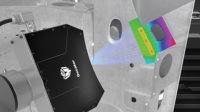Imaging applications using short-wave infrared (SWIR) wavelengths identify unique characteristics of objects that would be otherwise difficult to detect. Visible and near-infrared (NIR) imaging capture light reflecting off objects, while the longer wavelengths of thermal imaging detect the infrared radiation emitting from objects. SWIR wavelengths, on the other hand, capture interesting information between those wavebands. Things that are invisible under white light may become visible, objects that are opaque under white light can become transparent, and contrast may be increased between different materials that would otherwise appear identical (Figure 1).
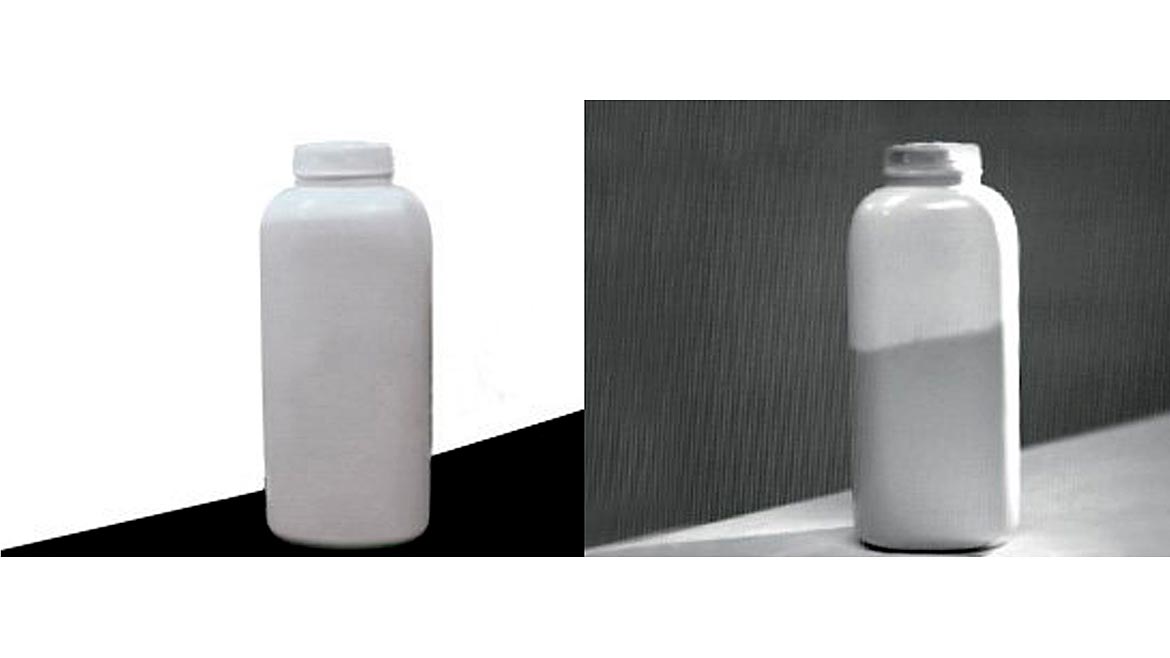
These traits make SWIR imaging systems powerful tools, but complexities and inefficiencies in SWIR sensors and light sources have resulted in slow adoption in the past. However, advancements in SWIR image sensors and illumination have made these systems more accessible than ever before, opening up a wave of new SWIR applications. But because of the unique ways SWIR wavelengths interact with objects, there are unique considerations when selecting SWIR lighting, cameras, and lenses compared to visible and NIR systems.
SWIR Sensor Advancements
Recent advancements in the manufacturing processes for SWIR imaging sensors have resulted in new, affordable sensors covering visible and SWIR wavebands with a high quantum efficiency (QE) covering wavelengths from 0.4 to 1.7µm. QE describes the efficiency of incident light being converted to electric signals. These new sensors also feature small pixel sizes (5µm) and low noise. While these qualities have been available in sensors covering visible wavelengths for years, they weren’t as accessible in SWIR solutions until more recently.
Indium gallium arsenide (InGaAs) sensors achieving high performance over SWIR wavelengths have been available for some time, but they are complex to manufacture and, therefore, expensive. They can achieve the best efficiency and sensitivity out of the available SWIR sensor technologies, but they are cost-prohibitive for many systems. Sony’s new CMOS-like SWIR sensors may not achieve quite as high performance as InGaAs sensors, but they achieve resolution, noise, and efficiency levels that are more than sufficient for many machine vision applications at a significantly lower cost.
Key Considerations for SWIR Illumination
For any vision application, the choice of illumination is crucial to achieve repeatability, consistency, accuracy, and effectiveness. When designing a vision system, four key considerations need to be taken into account:
- Setup: What is the Field of View? The working distance? The space constraints? The acquisition speed?
- Material: What are its optical characteristics? Reflectivity vs. diffusivity? Absorbance vs. transmittance? Spectral response?
- Environment: Ambient light presence? Operating temperature? Harsh conditions (dirt, dust, oil, humidity, or waterproofing considerations)?
- Inspection details: Type of defect or inspection? Typical dimensions and characteristics? Position and angle of the camera?
Getting these answers is needed to define the correct light wavelength, form factor, intensity and diffusion required as well as an enclosure adapted to the environment. This is true for any vision application, visible or invisible. However, one aspect is even more important and challenging when dealing with SWIR imaging than the above four considerations: determining the correct wavelength.
Selecting the Proper Wavelength Range for Illumination and Imaging
Knowing up front which SWIR wavelengths will work is difficult because our eyes are not sensitive in this range. In the visible range, for example, it is usually quite easy to guess if red illumination will highlight red components or if blue light will make the background dark. SWIR imaging typically requires the system designer to obtain the spectral properties of the different materials being imaged in advance, since interactions with SWIR wavelengths are not as intuitive.
There are several ways to determine the correct SWIR wavelength for an application. The first way is to find documentation on the material being imaged. Absorbance or transmittance graphs reveal which wavelength(s) will be dark or bright and which ones will provide the best contrast.
For example, silicon is a well-known material that is transparent to SWIR wavelengths longer than 1100nm (Figure 2). Therefore, it is very common to use SWIR imaging for various types of silicon defect inspections such as a crack detection, bonding inspection, spotting internal defects on the wafers themselves, or the detection of defects in circuits formed with different materials on silicon substrates.
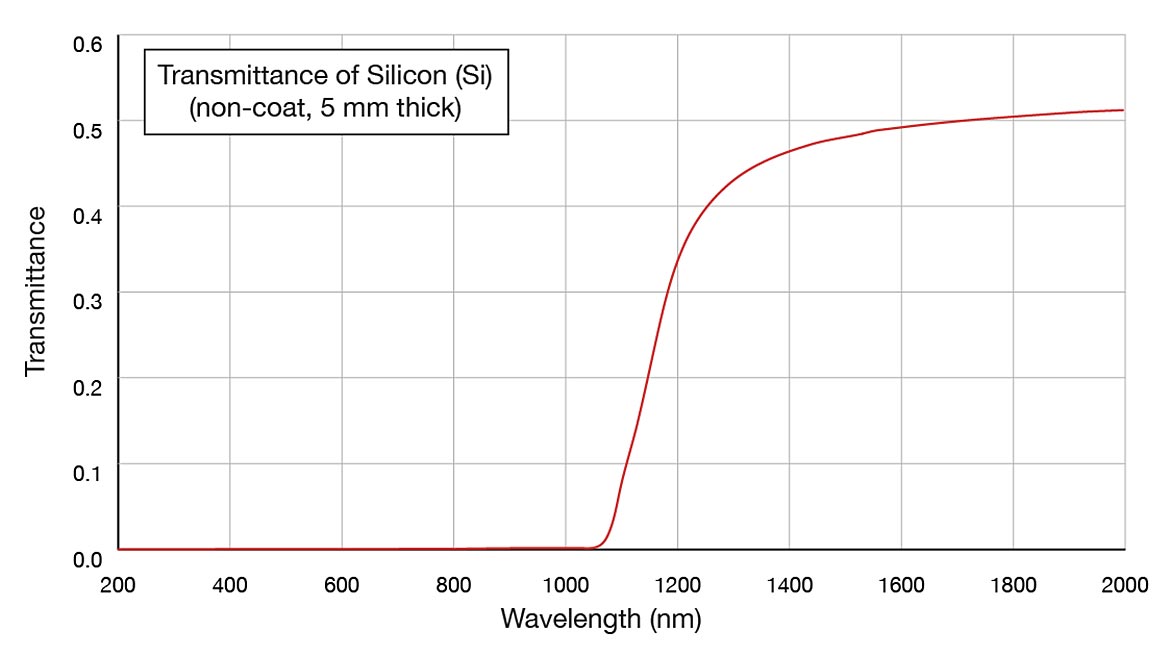
Another very common SWIR imaging use case is identifying moisture (Figure 3). Water has an absorption peak around 1450nm that will appear very dark to a SWIR imager. This can be applied to many applications such as moisture detection in food processing, fruit inspections, bottle fill level inspections, liquid differentiation, and even agricultural applications.
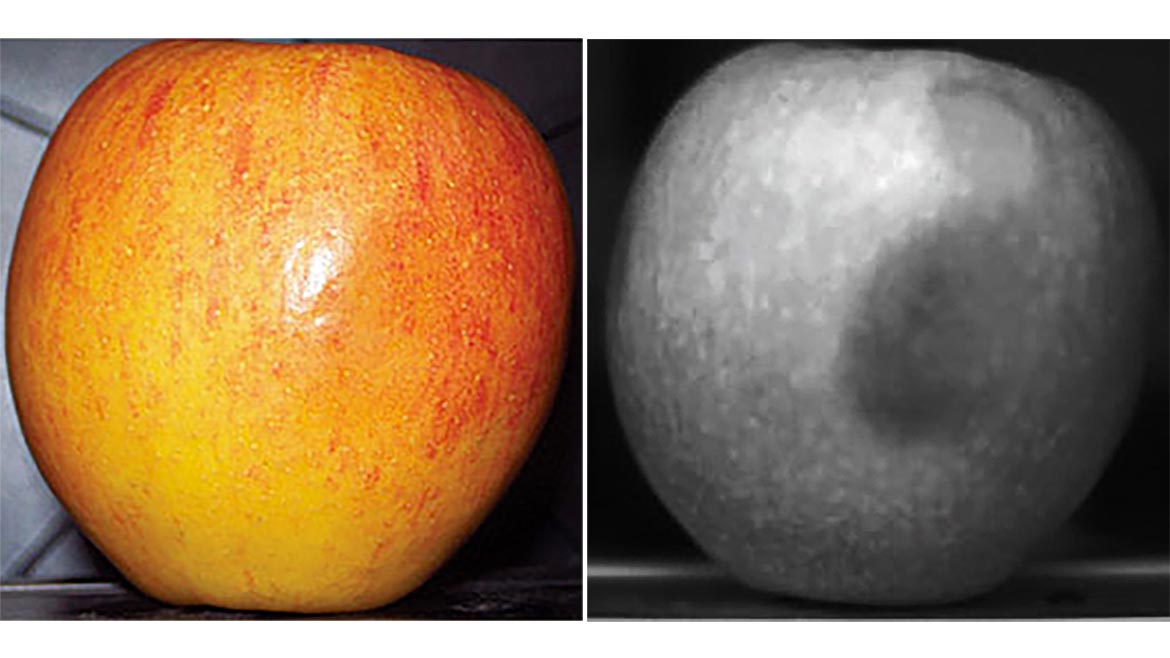
A SWIR hyperspectral camera and a broadband light source can also be used during the system development phase to determine the best wavelengths to focus on. This results in images covering many different wavelengths and a spectral signature for each pixel. Thanks to this information, the user can determine if one or few wavelengths have a strong peak of absorption or transmission in the given application that accomplishes the application goal. Generally, the goal is to maximize contrast.
For example, using this technology, the user can determine a spectral signature from different liquids where the composition or the optical characteristics are not known, and then select the best wavelength to highlight one or the other components (Figure 4). Then in the final system, an illumination source optimized for this specific wavelength and a regular SWIR camera can be used. This will result in a more cost-effective final system.
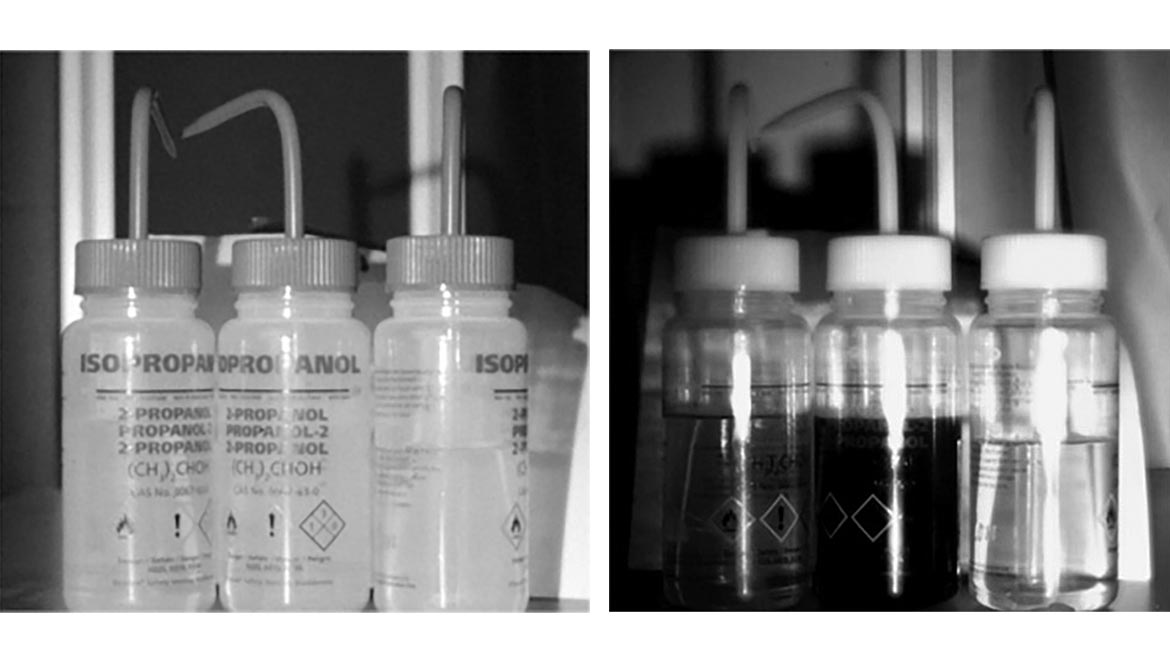
When using the hyperspectral light source and camera during product development, if contrast cannot be maximized by using a single wavelength, then the final solution may need to use these more complicated hyperspectral systems. As will be discussed later, this also increases the complexity and cost of the imaging lenses used. This situation ends up happening in many material sorting applications like plastic recycling, food quality inspection, and foreign material detections. Figure 5 shows that different plastics have unique spectral signatures, exhibiting different transmission and absorption in SWIR based on the chemical composition. Therefore, this signature can be used to discriminate and sort different materials.
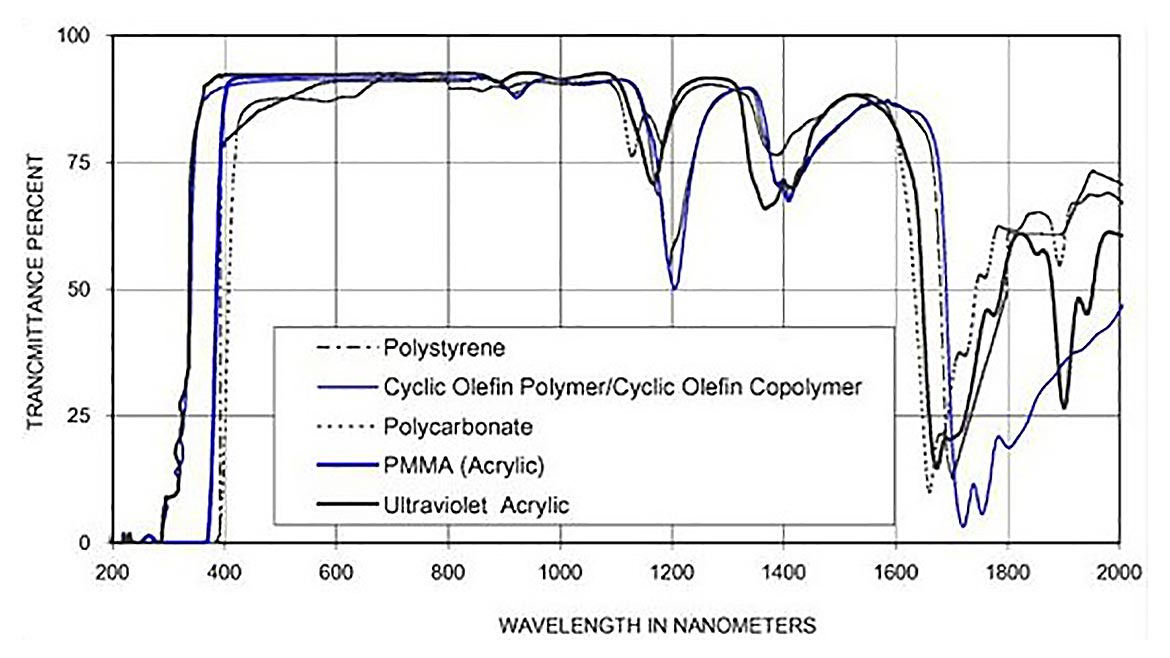
Key Considerations for SWIR Imaging Lenses
Vision & Sensors
A Quality Special Section
While it is true that many imaging lenses designed for visible wavelengths can also transmit SWIR radiation, you will get much better performance out of lenses specifically designed for SWIR use. This changes how the lens design is optimized for the desired waveband, the glass types chosen for maximum light throughput, and coatings chosen to also maximize throughput.
Also, applications taking advantage of the visible and SWIR wavebands detected by the new Sony visible-SWIR sensors need to consider chromatic aberrations. Dispersion causes different wavelengths to be bent differently by glass lenses, and these effects are more noticeable when using a broader wavelength range. Chromatic aberrations can be minimized during the lens design process by carefully balancing materials with different dispersion values (Figure 6). However, this increases costs. So while some systems that require using both visible and SWIR light can be enabled by more expensive visible-SWIR lenses, many applications may just use a smaller SWIR waveband of the sensor and therefore be able to use a less-expensive lens just designed for those wavelengths.
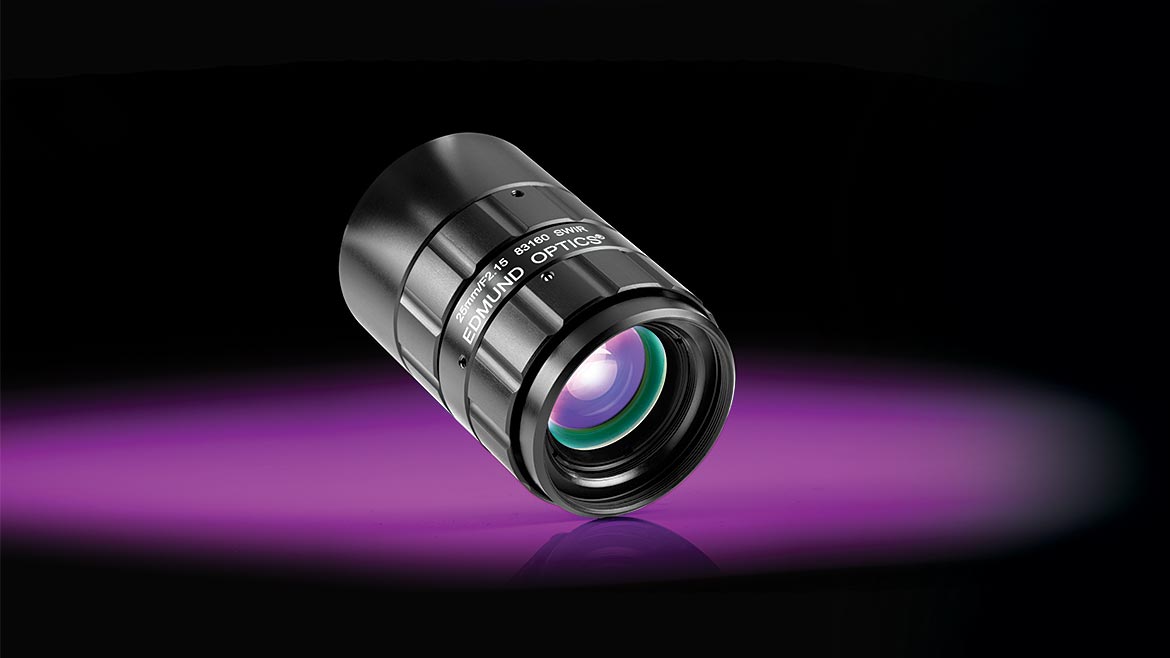
SWIR illumination and imaging unlock powerful new ways of differentiating materials and chemicals that look similar under visible light. While this high-level overview introduced the fundamentals of selecting the proper SWIR cameras, light sources, and lenses, reach out to your illumination and optical component manufacturers for guidance on selecting the right components for your particular application. From a wide range of SWIR light sources to SWIR imaging lenses, many options for SWIR components are now available to help make your SWIR system a success.



